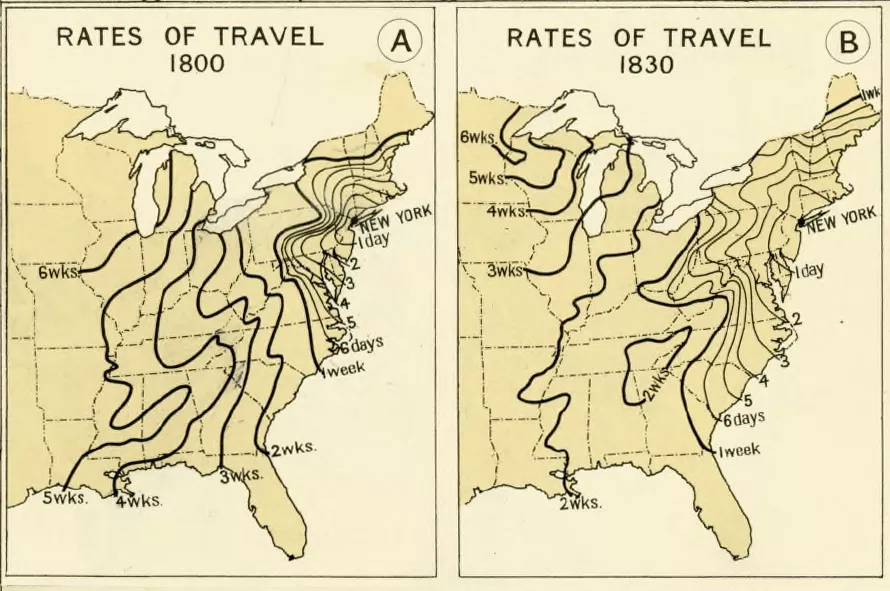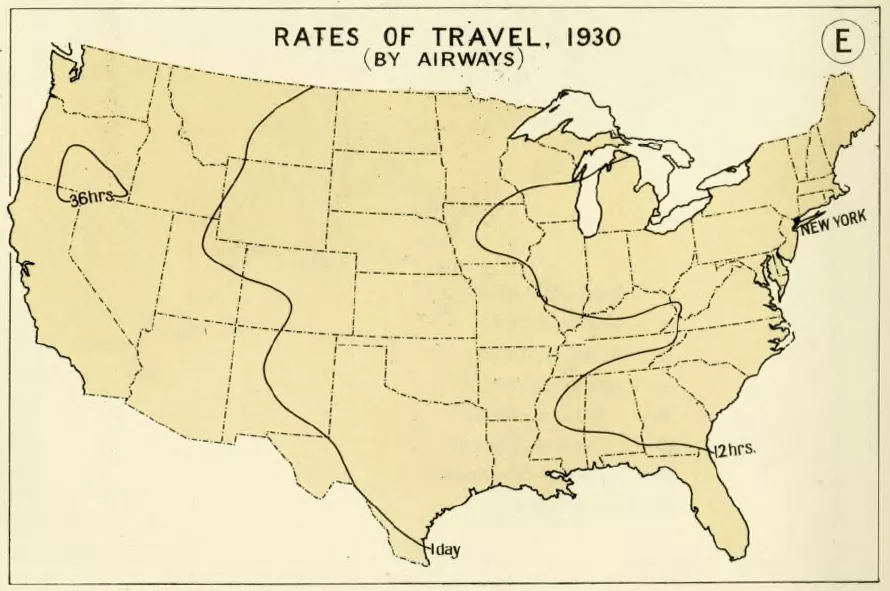Reducing Friction in Everyday Life
Improving Human Travel
The desired effect of technology is to make human life more bearable. Consider, for example, the history of travel. Even with modern technology, the act of traveling is notoriously burdensome. Picture yourself going away. Even traveling short distances involves exposing yourself to unpredictable situations and discomforts. Long-haul trips are worse. Loading, unloading, and otherwise pulling your belongings and your own weight to the destination. You feel time passing by, unrewarded for miles, hoping no accident falls upon you or a loved one. That is why nothing speaks of the human ability to endure sacrifice in pursuit of something higher than humanity's willingness and resolve to explore and tour the world.
But humankind has been quite successful at improving the travel experience through technological progress. Consider, for example, the magnitude by which travel times in the United States have shrunk since the 1800s:

 Travel times in the U.S. in 1800, 1830 and 1930. Hathi Trust
Travel times in the U.S. in 1800, 1830 and 1930. Hathi TrustIn little over a century, railways and air travel brought the whole country within reach. By the 1930s, the back-breaking, five-month journey from New York to California on covered wagon had been replaced by a string of short flights with catered meals. And yet, despite dramatic improvement, people would still think twice before flying to Los Angeles:
"In 1934 (...) a flight from New York to Los Angeles was a grueling ordeal, typically requiring 25 hours, more than one airline, at least two changes of planes and as many as 15 stops or so." — Smithsonian Magazine
Today it takes only six hours to fly non-stop from coast to coast, something unimaginable in the 1800s. But our accomplishments are not limited to making our journeys faster; travel today is also safer, more comfortable and more accessible than ever before. Overall, we have achieved to make travel much more ‘bearable’, mostly thanks to major developments on transportation technology and infrastructure:
- Roads and vehicles have reduced travel times and effort.
- Engine and turbine technologies made vehicles faster.
- The introduction of closed cabins increased comfort and safety.
- Brakes, seatbelts, and airbags made accidents less frequent and costly.
- In-cabin entertainment spared people of boredom (at least partially).
And testament to the value that these and other breakthroughs deliver are the billion-dollar industries that emerged around them, a true "show of force" of people's willingness to pay for a better travel experience.
The Markets to Reduce Friction
When we talk about making human life more bearable, we are talking about reducing ‘friction’. Frictions are burdensome experiences that make it harder for people to reach their goals. They are experiences we actively seek to avoid or mitigate before, during, and after our journeys in order to make the attainment of our goals less experientially costly.
Just like people are willing to pay for a better travel experience, people exhibit a willingness to pay for solutions that reduce friction in other aspects of life. In fact, a large portion of the economy is devoted to this. It's our collective desire to keep life livable which has given rise to markets that naturally form around people's most common and valuable goals. In these markets, firms and individuals offer "solutions" that help people deal with the frictions of life.
Two basic solutions to this effect are ‘products’ and ‘services’:
- Products are "equipment" that you can use in your journeys to make unwanted experiences less taxing.
- Services are a set of activities performed by a third party to relieve you from an unwanted experience.
Products: Friction-Fighting Equipment
Products are systems that reduce experiential costs for their user by means of their function:
- A heater spares the user the experience of feeling cold through heating.
- An umbrella spares the user the experience of getting wet by intercepting rain.
- A ride sharing app (e.g., Lyft, Uber) spares the user the experience of going to the curb and hailing a ride (among others) by sharing the user's location with an available driver.
Depending on features and performance, a product can either "attenuate" an unwanted experience (e.g., wearing earplugs to reduce ambient noise) or liberate the user from the experience altogether (e.g., killing the noise with noise-cancelling headphones). Product features also confer varying degrees of versatility: Some products are useful in many possible situations (consider a bicycle, a flashlight, a screwdriver), while others are used in very specific contexts (consider a diaper, a cocktail shaker, a pharmaceutical product).
It is often the case that the experience of using a product introduces new frictions into the journey which partially offset the experiential benefit it delivers. That is why products are designed for ‘usability’, a term that in a very general sense refers to the ease of use of a product. The more usable a product is, the less friction it introduces into the user's journey.
Services: Burdening of the Fittest
A service is a process that reduces friction for a beneficiary by transferring the burden to a service provider, typically a firm or an individual:
- Cleaning services transfer the experience of cleaning from the beneficiary to a service provider.
- Grocery delivery services transfer the experience of going to the market and picking groceries from the beneficiary to a service provider.
- Legal services transfer the experience of dealing with a legal matter from the beneficiary to a service provider.
After changing hands, the experiential cost may be lower for the service provider if they are someone better prepared to deal with the unwanted experience, either by skill, willingness, tolerance, or by means of using a better process or equipment. That is why services are particularly useful when a specialized skill-set is required to successfully reach a goal (for example, installing electrical wiring or fighting a lawsuit), sparing the beneficiary the time and effort they would have otherwise expended in acquiring those skills.
Depending on the sophistication of the service provider and the nature of the service being delivered, the service provider can bear the unwanted experience ‘as is’, meaning they directly take on the activities the beneficiary would have otherwise performed; or they can perform a different set of activities that delivers the same experiential result to the beneficiary. For instance, when someone buys an item through an online retailer (e.g., Amazon), the service provider may fulfill the order from a centralized warehouse instead of having an associate purchase the item from a brick and mortar location, as the customer would.
Even in its simplest form, the service is a very clever approach to reduce friction because it does not change the experience itself, it just changes the bearer. In this sense, services help the purpose of ‘reshuffling’ friction among people, leaving everyone carrying the undesired experiences they are more willing or capable to handle. One thing to keep in mind is that, like in the case of products, the value delivered by services is partially offset by the frictions that result from interacting with service providers.
Products vs. Services
You might be tempted to think that services are an inferior solution because they merely ‘pass on’ the experiential cost to someone else instead of mitigating it directly like products do. However, the firms and individuals that deal in products also incur in considerable experiential costs designing, developing, and delivering them.
In Reality, both solutions have advantages over the another. Unlike products, services can be deployed without the need for capital or new technology, all it takes is a willing service provider with enough skill to deliver the desired experiential relief. On the other hand, unlike services, many products are reusable and continue delivering value with every use, amortizing the experiential cost incurred in their development across every copy of the product in use. Products also offer users more independence and privacy since they do not require the involvement of a service provider.
On the downsides, products and services sometimes produce ‘externalities’ – experiential costs imposed on unrelated third parties. A well-known example is the automobile, perhaps one of the most successful products the world has seen, which has also brought about traffic, pollution, and fatalities. As the mixed bag of costs and benefits that they are, what products and services really offer us is a choice.
The rise of products and services as the quintessential offerings of the modern economy has given us the opportunity to shape every aspect of our lives. The very acts of finding them, buying them, and using them have become a staple of human experience; it only takes a quick look around to remind ourselves of their ubiquity. And even yet, large portions of our lives remain frictional... How frictionless can we make it? Or perhaps more importantly, how frictionless should we make it?
✎ Connection to
Key / Elements of New Technology Development
Key / The Human Sense of Value